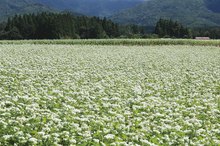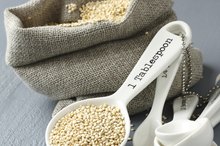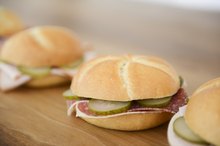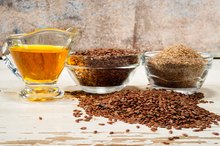What Is the Difference Between Corn Meal & Corn Gluten Meal?
Because corn meal and corn gluten meal have similar names and spring from the same crop, it’s natural to assume they have similar uses. In fact, corn meal is a food-grade product, while corn gluten meal is primarily meant for farming and gardening. Both can be useful to the self-sufficient householder, but they shouldn’t be substituted for one another.
Corn Meal
Corn meal is made by grinding dried corn kernels. Manufacturers use grain corn, as opposed to varieties used for fresh eating or for popcorn. Most grain corn becomes animal feed, but about 10 percent is used for food products like corn meal and corn flakes, according to Purdue University 2.
Corn Meal Uses
Is Hydrolyzed Corn Gluten Safe for Celiacs?
Learn More
Use corn meal to coat meats, fish or chicken before cooking, or as as the main ingredient in breads, muffins and pancakes. Unlike other flours, corn meal also works well as a breakfast cereal, as dessert pudding or in hearty dinner dishes like polenta. The gluten-free grain is often enriched with calcium and with B and D vitamins, according to University of Minnesota’s extension program 12.
Corn Gluten Meal
Corn gluten meal is a by-product of the corn milling process. The part of the kernel that doesn’t get used in products like corn meal has value as animal food or in farming and gardening. Corn gluten contains about 60 percent protein and 10 percent nitrogen.
Corn Gluten Meal Uses
Oat Substitutes
Learn More
Corn gluten meal is not edible by human standards, although it has food applications for pet, cattle and poultry feed. In the early 1990s, researchers discovered that corn gluten meal also had value as an organic herbicide and fertilizer. Specifically, gluten meal targets weed seeds which have not yet begun to sprout, and prevents them from germinating. For this reason, corn gluten meal works best when applied in the spring, or just before the emergence of late-blooming weeds. It does not control annual weeds which have already sprouted, nor established perennial weeds. On the other hand, corn gluten meal is effective in stopping the emergence of seeds cast by perennial weeds, which controls their spread. Rodale’s “Ultimate Encyclopedia of Organic Gardening” also recommends using corn gluten meal as a natural fertilizer 3. Its 10 percent nitrogen content makes it a suitable substitute for manure or artificial nitrogen fertilizers, according to the encyclopedia. Because corn gluten meal prevents seeds from germinating, it should only be applied to established gardens or lawns.
- Corn gluten meal is not edible by human standards, although it has food applications for pet, cattle and poultry feed.
- Because corn gluten meal prevents seeds from germinating, it should only be applied to established gardens or lawns.
Overlapping Uses?
Corn meal is primarily a food ingredient, while corn gluten meal cannot be used as “people food.” Some research has been done to see if regular corn meal has any applications in farming and gardening, especially as a fungicide. According to the Washington State University’s extension service, the advice about using food-grade cornmeal in the garden is not credible 12. Corn meal is best left in the kitchen, while corn gluten meal should be relegated to the garden shed or chicken house.
Related Articles
References
- University of Missouri Extension: Using and Storing Cornmeal
- Purdue University: Corn
- "Rodale's Ultimate Encyclopedia of Organic Gardening"; Fern Marshall Bradley, et al; 2009
- Corn, sweet, yellow, raw. FoodData Central. U.S. Department of Agriculture. Published April 1, 2019.
- Choosing good carbs with the glycemic index. Harvard Health Publishing, Harvard Medical School. Updated 2012.
- Corn. Grains & Legumes Nutrition Council. Updated 2020.
- Luna-Vital DA, Gonzalez de Mejia E. Anthocyanins from purple corn activate free fatty acid-receptor 1 and glucokinase enhancing in vitro insulin secretion and hepatic glucose uptake. PLoS ONE. 2018;13(7):e0200449. doi:10.1371/journal.pone.0200449
- Harvesting the health benefits from corn. Tufts University Gerald J. and Dorothy R. Friedman School of Nutrition Science and Policy. Updated 2013.
- Njike VY, Smith TM, Shuval O, et al. Snack food, satiety, and weight. Adv Nutr. 2016;7(5):866-78. doi:10.3945/an.115.009340
- Popcorn, air-popped, unbuttered. USDA FoodData Central. April 1, 2020
- Vitamin A: Fact Sheets for Health Professionals. National Institutes of Health, Office of Dietary Supplements. Updated 2020.
- Magnesium: Fact Sheets for Health Professionals. National Institutes of Health, Office of Dietary Supplements. Updated 2020.
- Corn Allergy. American College of Allergy Asthma & Immunology. Updated 2019.
- Corn. Non-GMO Project. Updated 2016.
- GMO Crops, Animal Food, and Beyond. U.S. Food and Drug Administration. Updated 03/04/2020
- High Fructose Corn Syrup Questions and Answers. U.S. Food and Drug Administration. Updated 2018.
- Bray GA. Energy and fructose from beverages sweetened with sugar or high-fructose corn syrup pose a health risk for some people. Adv Nutr. 2013;4(2):220-5. doi:10.3945/an.112.002816
- Different types of corn. The Popcorn Board. Updated 2020.
- Corn. USDA SNAP-Ed Connection.
- Corn. Grains & Legumes Nutrition Council. Updated 2020.
- Sweet Corn. Purdue Extension FoodLink. Updated 2014.
Writer Bio
Ellen Douglas has written on food, gardening, education and the arts since 1992. Douglas has worked as a staff reporter for the Lakeville Journal newspaper group. Previously, she served as a communication specialist in the nonprofit field. She received her Bachelor of Arts from the University of Connecticut.









